Arrow’s Savage Guns: 4 Classic Westerns on Blu-ray
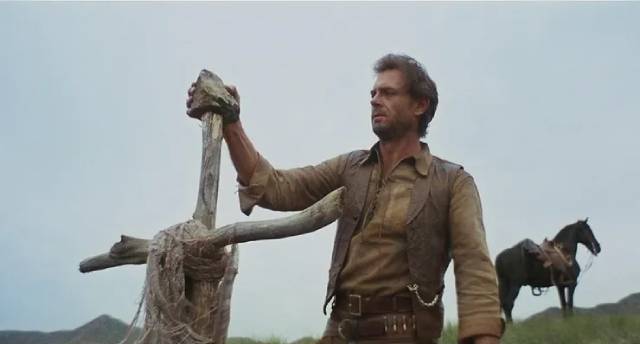
My new year viewing began with a bang … actually several bangs, thanks to Arrow’s release of their third collection of spaghetti westerns, Savage Guns. Perhaps it was just my mood (an excess of turkey dinners and a consequent feeling of lethargy), but this seems a stronger set than last summer’s volume two, Blood Money. Volume three includes only one movie I’d previously seen – Lucio Fulci’s The Four of the Apocalypse (1975) – two by directors I’ve seen other movies by – Edoardo Mulargia’s El Puro (1969) and Paolo Bianchini’s I Want Him Dead (1968) – and one by a director new to me, Mario Camus’ Wrath of the Wind (1970).
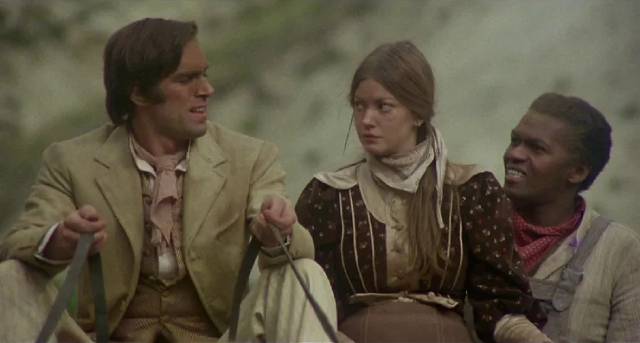
The Four of the Apocalypse (Lucio Fulci, 1975)
It seems counter-intuitive that Lucio Fulci, best-known for his horror movies and gialli, should have tackled the spaghetti western, and yet he returned to the genre several times in the ’60s and ’70s. In fact, it was with his first western, Massacre Time (1966), that he began to break away from directing the comedies he was then known for – he made sixteen in seven years – although he followed that with three more comedies before branching out again, with the thriller One on Top of the Other and the historical drama Beatrice Cenci (both 1969). After two of his best gialli – A Lizard in a Woman’s Skin (1971) and Don’t Torture a Duckling (1972), and a pair of adventures based loosely on Jack London’s 1906 novel White Fang, Fulci returned to the western again as the genre was in serious decline.
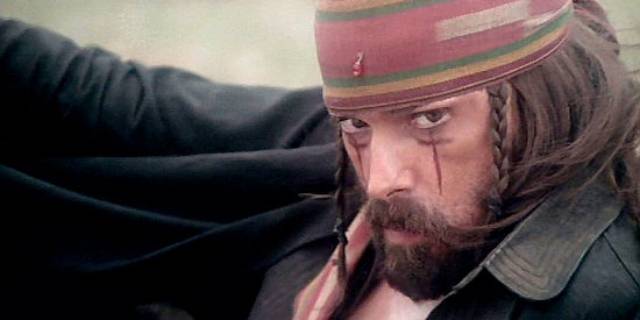
The Four of the Apocalypse seems to some degree to recognize this decline; its loose, episodic narrative is steeped in melancholy and largely devoid of the mythic tone of many of the better-known movies of the previous decade. Based on a pair of short stories by Bret Harte from the 1860s, as scripted by Ennio De Concini, it’s essentially a period road movie in which an odd assortment of characters are thrown together on a journey fraught with various dangers. The four of the title are gambler Stubby Preston (Fabio Testi), prostitute Bunny O’Neill (Lynne Frederick), drunkard Clem (Michael J. Pollard) and (former slave?) Bud (Harry Baird), who all meet in a small town jail.
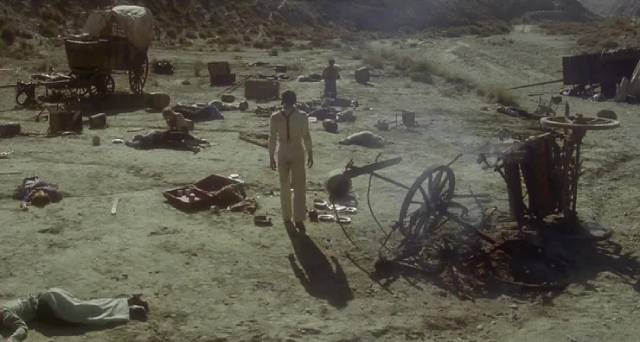
That night, masked vigilantes, under protection of the sheriff (Donald O’Brien), slaughter all the town’s undesirable elements. The four escape death only because they’re locked up. The next day, tied together, they are led through streets littered with bodies to the edge of town and sent into exile. Taking Stubby’s money, the sheriff provides them with a wagon and horses and they head out into the empty landscape where they encounter a wagon train of friendly Quakers and we learn that Bunny is pregnant. Later, as they rest by a river, a stranger enters their camp. Chaco (Tomas Milian) exudes an air of violence, but when he uses his guns to slaughter a lot of birds, providing the group with food, they lower their guard.
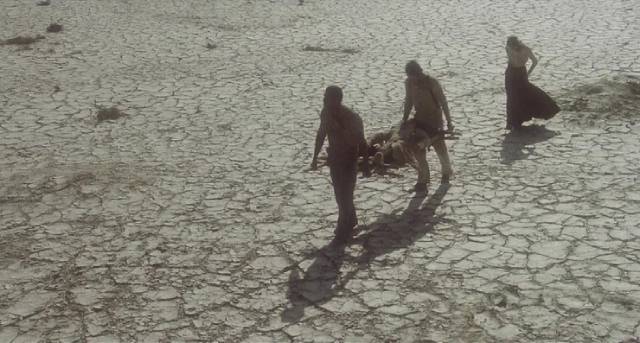
This proves a mistake as he overpowers them all, rapes Bunny, shoots Clem in the leg, and makes off with the wagon and horses. Carrying Clem on a makeshift stretcher, they wander through a variety of landscapes before arriving at a deserted town in torrential rain. Bud reveals his affinity for the dead as he rushes naked through the local graveyard in the rain, speaking to the spirits. Clem finally dies and Bud seems to become one of the spirits, disappearing by the time the rain stops and Stubby and Bunny are ready to move on.
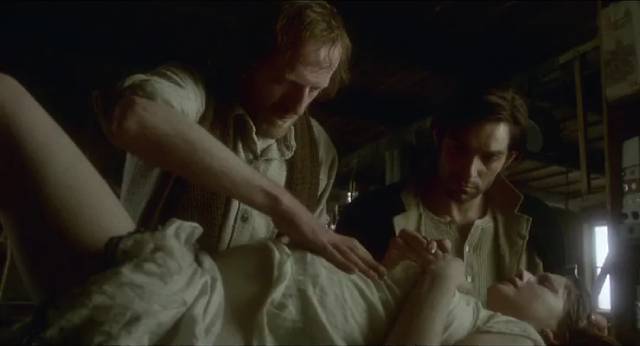
Wandering into the mountains, they eventually arrive at a snowbound mining town populated by men who seem to believe that the presence of a woman is a bad omen. And yet these hardened, antisocial miners find themselves drawn into the drama as Bunny goes into labour, a couple of them taking charge as Stubby looks on helplessly. The miners gather in the snowy street, drinking and making bets on the gender of the baby, even the most embittered finally giving in when they hear the baby’s first cries.
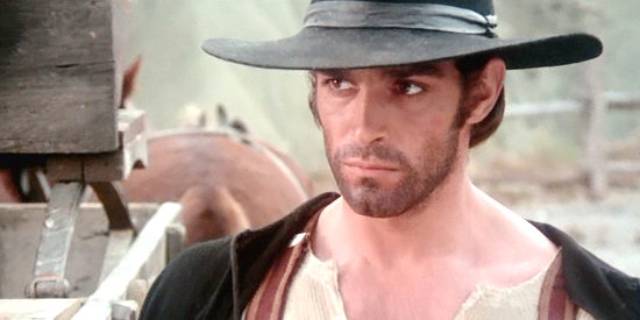
Stubby, devastated by Bunny’s death during the birth, leaves the newborn with these men who adopt the baby as their own, and once again wanders into the wilderness, sole survivor of the four. In an oddly throwaway coda, he encounters Chaco again and kills him before continuing his journey. In a landscape forged by violence, various characters meet, form transitory bonds, survive or die at random and occasionally leave their mark. There’s an element here of the traditional western trope of the intersection – and antagonism – of wilderness and community, but the film frequently up-ends the standard treatment, with the town at the beginning being a monstrous site of violence and the open landscape a place where bonds can form and grow. The ghost town where the four pause is haunted by the dead, claiming both Clem and Bud, while the mining town at the end, full of hardened men, is transformed by the death of Bunny and arrival of the child the miners name Lucky. But Stubby himself never finds a place to belong and is last seen riding into the distance accompanied by a stray dog.
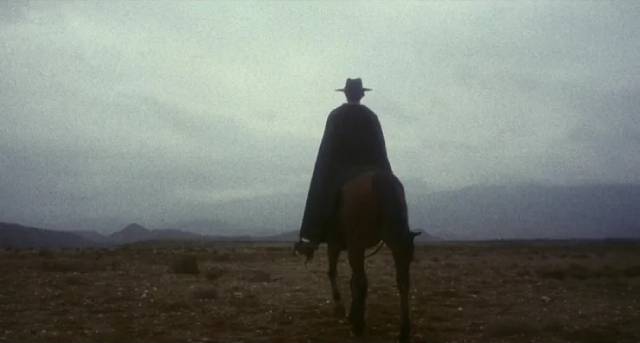
The elegiac tone and occasionally mystical treatment of landscape (the striking imagery shot by Sergio Salvati in just his third feature as cinematographer and first of eight collaborations with Fulci) link the film to Fulci’s greatest giallo, Don’t Torture a Duckling, made a few years earlier, while moments of horrific violence (Chaco’s massacre of the Quakers) and the ghostly aura of the abandoned town point towards the more overt horror of the run of movies which began with Zombi 2 (1979) a few years later – which suggests that in addition to other qualities as a filmmaker Fulci was an authentic auteur.
*
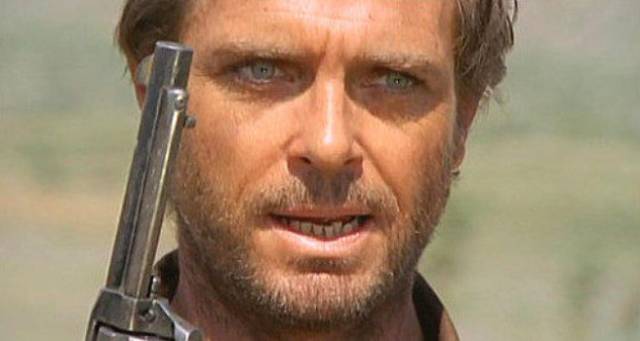
I Want Him Dead (Paolo Bianchini, 1968)
Craig Hill began his acting career in Hollywood with parts in a number of major movies in the early ’50s, gradually shifting to television work by the middle of the decade, eventually heading for Italy around the same time as Clint Eastwood to appear in westerns as that genre proliferated. I Want Him Dead, directed by Paolo Bianchini, was his fifth in three years. As with many spaghetti westerns, the Civil War casts a shadow over this one; Hill plays Clayton, a Confederate soldier planning to buy some land and settle down with his sister Mercedes (Cristina Businari). He makes the mistake of leaving her alone in the hotel in town as he rides on to meet an old friend about the land deal; as he learns that his Confederate dollars, scrupulously saved over the past three years, are now worthless, back in town a pair of thugs rape and kill Mercedes.
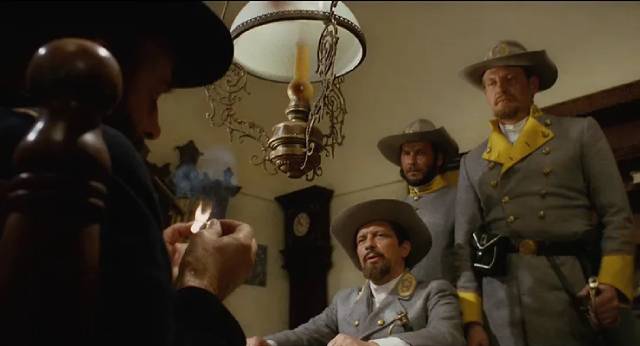
Those thugs, Jack Blood (Jose Manuel Martin) and Harry Gunn (Andrea Scotti), work for the very wealthy Mallek (Andrea Bosic), who having grown fat on war profits is not happy about the imminent end of the conflict which will leave him holding a lot of suddenly worthless supplies. As Clayton infiltrates the Mallek ranch, aided by the much abused servant Aloma (Lea Massari), Mallek is planning to ensure that the war will continue by assassinating the generals negotiating a ceasefire. Clayton’s personal quest for revenge purely by chance puts an end to the plot and ensures the peace.
Hill does a fine job as the hero, ably supported by Massari, whose Aloma is a more substantial character than those typically given to women in spaghetti westerns. The confluence of the personal with the larger political narrative adds weight to the story – something also apparent in Bianchini’s Gatling Gun, made later the same year – while adhering to the genre’s familiar themes of greed and revenge (Clayton shares a motive with Lee Van Cleef’s Colonel Mortimer in Sergio Leone’s For a Few Dollars More [1965], tracking the bandit who murdered his sister).
*
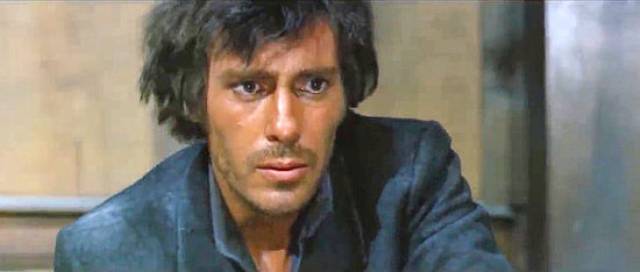
El Puro (Edoardo Mulargia, 1969)
Edoardo Mulargia’s El Puro is the weakest movie in the set. The only Mulargia movie I’ve previously seen was Tropic of Cancer (1972), a messy kind-of giallo set in Haiti, so I don’t have a lot of context to judge exactly what’s wrong here. Part of the problem is the lead performance by spaghetti western veteran Robert Woods, who plays Joe “El Puro” Bishop as an irritating, unsympathetic character. A former gunfighter who’s fed up with his old life, he’s now a sullen alcoholic shacked up with saloon girl Rosie (Rosalba Neri) and trying to avoid all the bounty hunters hoping to claim the $10,000 reward on his head.
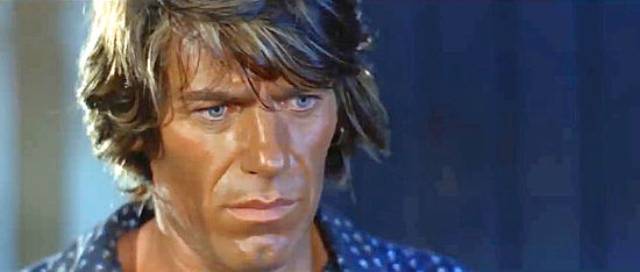
Mulargia establishes a tone and pace in the opening sequence reminiscent of Leone’s audacious prologue to Once Upon a Time in the West (1968), in which inaction and waiting become the narrative core. But Mulargia doesn’t have Leone’s masterful control of the material and El Puro too often slips into lethargy which is exacerbated by Woods’ sullen performance. Audience engagement is further alienated with the protracted, extremely brutal sequence in which two men searching for El Puro, Cassidy (Aldo Berti) and Tim (Mario Brega), savagely beat Rosie to death trying to get her to reveal her lover’s location. This ends with an unsettling, passionate kiss between than two men, suggesting that they find their own violence against the woman sexually arousing.
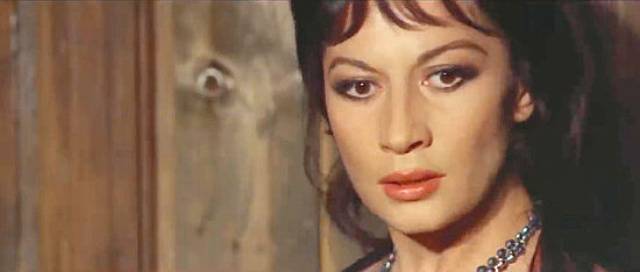
It’s only in the last half hour that El Puro starts to pull himself together and prepare for a climactic showdown with the gang of bounty hunters, a sequence which pretty much goes by the numbers in a dusty street. Rather than a sense of catharsis, though, it has an air of futility which is hammered home in the last few shots as El Puro rides out of town only to be shot in the back by the man who seemed to be his only friend – loyalty is nothing in the face of a substantial bounty.
*
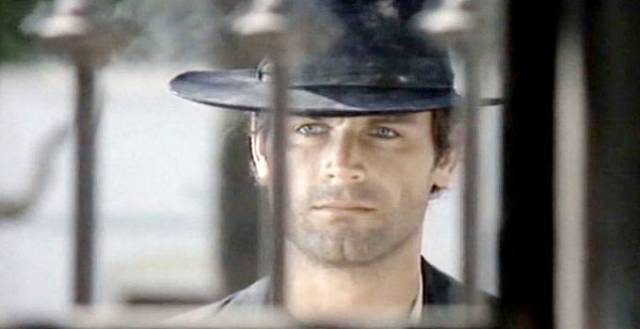
Wrath of the Wind (Mario Camus, 1970)
The most interesting film in the set is Mario Camus’ Wrath of the Wind, in part because it stretches the boundaries of the genre in a number of ways. Although there are many western signifiers, its period and setting are not clearly defined. This stems from it having been made in Spain by a Spanish filmmaker in the midst of the Franco dictatorship, requiring a degree of misdirection because at its core it provided a coded critique of contemporary politics. Visually, it might be perceived as set in Mexico in the early years of the 20th Century. Ostensibly, it takes place in Southern Spain around the turn of the century, although it features cowboys in familiar western outfits on horses. It’s as if the movie is wearing a mask that it invites the viewer to see behind.
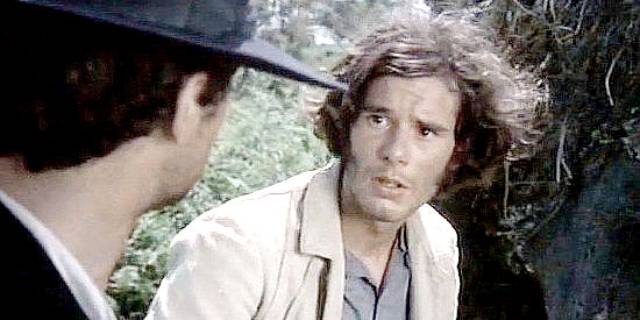
The genre connection is reinforced by the casting of Terence Hill in the lead. He was almost twenty years into a career in which he had appeared in numerous, varied films, mostly under his real name, Mario Girotti – he was in Luchino Visconti’s historical epic The Leopard (1963) as well as many German movies, including a number of Karl May-based westerns – before he began making spaghetti westerns in 1967. By 1970, he had five Italian western credits, making him readily identifiable as a genre hero – it was immediately after working with Camus that Hill made They Call Me Trinity (1970), which made him an international star while mocking the conventions of the genre. That comic persona became so familiar that all the more serious work which had preceded it became somewhat obscured, but the later image casts an odd light on his role in Wrath of the Wind, which now seems unexpectedly dark.
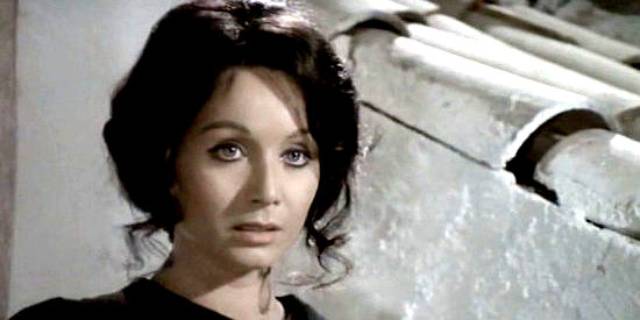
We first see Hill’s Marco in a crowded town plaza, standing against a wall and watching the bustling activity of a prosperous populace. He makes eye contact with another man across the square, whom we eventually know as Jacobo (Mario Pardo). As an obviously prominent man makes his way through the crowd, receiving deference from those he deigns to greet, the pair close in, pull out guns, and assassinate him, easily escaping in the confusion. In their room, they’re visited by a man who appears to be a kind of agent, bringing them assignments; he offers them an “easy” job down South, handing them detailed written instructions.
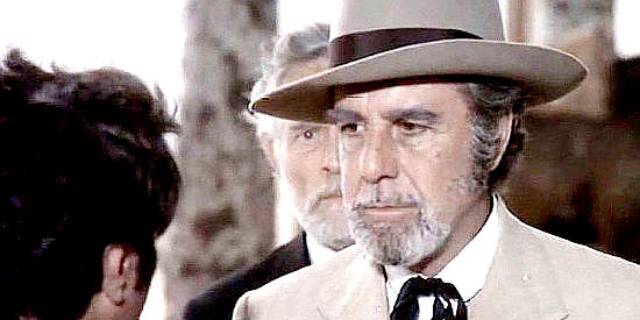
And so they take a train and arrive in a rural area where they split up, Marco taking a room at the local inn. Everyone he meets seems to be expecting him, puzzled that he doesn’t respond or identify himself. He waits and watches, observing the inn’s owner Soledad (Maria Grazia Buccella) and her fractious relationship with Ramon (Maximo Valverde), the son of powerful landowner Don Antonio (Fernando Rey). As Marco waits, we become aware of tensions in the community – the resentment of workers who barely subsist on what the landowners pay for their labour. Although at least one landowner, Don Lucas (William Layton), believes that it would be better to pay a living wage, Don Antonio is disgusted by the idea that owners owe anything to the peasants.
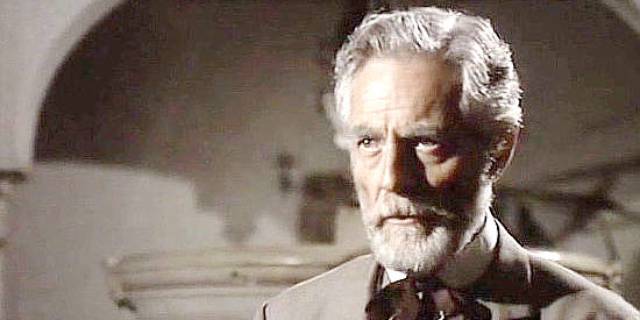
And then the man everyone was mistaking Marco for arrives. He is a political agitator (Carlo Alberto Cortina) tasked with guiding the workers’ efforts to organize and present collective demands for higher wages and better conditions. Tensions escalate, with Don Antonio becoming more intransigent, while Don Lucas, guided by his conscience, offers higher wages – the workers all refuse to work for anyone other than Don Lucas, threatening the crops and profits of the other landowners. And then Marco makes his move, assassinating the organizer after one of his meetings.
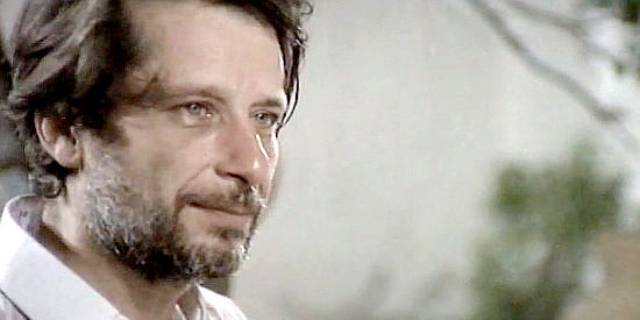
But although he fulfills the contract, Marco has been affected by what he has seen and he stays on, partly because of his relationship with Soledad, but also because he is waking up to the effects of social and economic inequality. By the time Jacobo reappears as one of the landowners’ enforcers, Marco has come to side with the workers and the two friends who have been together since their shared childhood in an orphanage have a falling out, each taking an opposing side as the violence escalates.
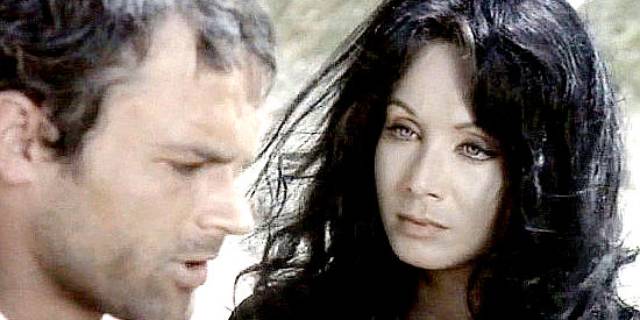
Camus addresses the existing inequities in Franco’s Spain through a genre lens, using Hill’s character – an agent of oppression who gradually awakens to the true nature of the system he has played a part in propping up – as a vehicle to lead the audience towards an irrefutable critique of that system. Although until now I’ve been unaware of Camus and his work, it’s interesting to note that his most celebrated film, The Holy Innocents (1984), covers much the same ground, but without the genre mask – made six years after Franco’s death, Camus was finally able to address these issues directly.
*
As with Arrow’s previous spaghetti western sets, Savage Guns displays a range of possibilities within the genre and the different tacks taken by a variety of directors. All transfers look fine, though in a couple of cases slightly uneven – all were transferred from original camera negatives, though the longer version of El Puro is supplemented from a print. Each movie gets a commentary, plus cast and crew interviews, along with Stephen Thrower talking about Lucio Fulci and Lovely Jon discussing the scores of El Puro and The Four of the Apocalypse. In addition to the longer cut of El Puro, there’s also an extended cut of Wrath of the Wind.
Comments